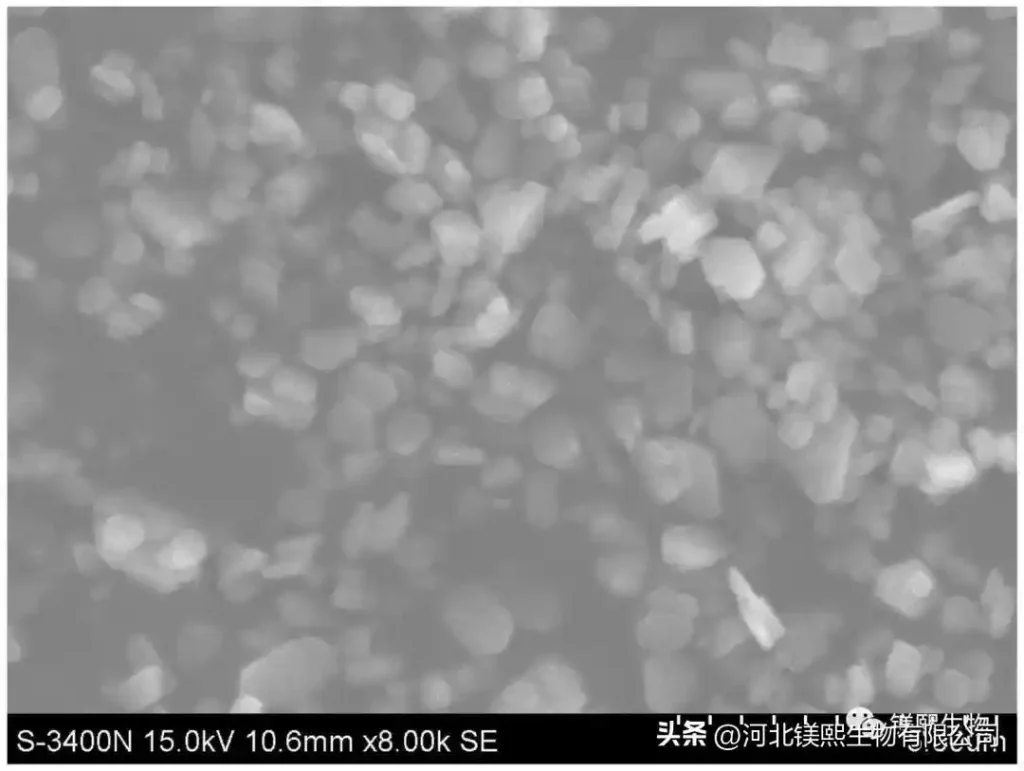Magnesium hydroxide (magnesium hydroxide,) as an important chemical product and intermediate, has a wide range of applications. In the field of environmental protection, it is called “green and safe water treatment agent”, which can be used for neutralization of acid-containing wastewater, decolorization of printing and dyeing wastewater, removal of heavy metals, flue gas desulfurization, etc. It can also be used as antacid agent for medicine, antibacterial and bactericide, protective agent for paper and precursor for preparing magnesium oxide.
As an environmentally friendly inorganic flame retardant, magnesium hydroxide has the advantages of environmental protection, high thermal stability, flame retardancy, smoke elimination, and drip resistance, and has become a research hotspot for scholars. However, the magnesium hydroxide synthesized under normal temperature conditions is mostly agglomerated solid, the average particle size of a single particle is small, the specific surface area (BET) is large, the surface polarity and microscopic strain of the (101) surface and (110) surface are large, and the crystal grains are easily Secondary agglomeration occurs, and the dispersion in high molecular polymer materials is poor, which affects the processing performance of composite materials.
Hebei Messi Biology Co., Ltd. stated that hydrothermal modification technology is an effective method to reduce the surface polarity and surface microscopic strain of magnesium hydroxide, increase crystal crystallinity, and improve particle dispersion. However, direct hydrothermal magnesium hydroxide slurry, due to the high hydration characteristics of magnesium hydroxide, there is a large amount of crystal water on the surface of the new nucleus, which hinders the superposition of growth elements on the surface of the new nucleus and inhibits crystal growth. It takes a long time and consumes a lot of energy. The researchers also explored adding magnesium hydroxide filter cake to the hydrothermal mineralizer, thereby reducing the hydrothermal time and improving the dispersibility of magnesium hydroxide.

Hydrothermal in CaCl2 solution can get flake magnesium hydroxide with an average particle size of about 0.3~0.7μm and a BET value of 10.5m2 g-1, but the purity of magnesium hydroxide will inevitably be reduced due to the addition of Ca2+. decline. Flake magnesium hydroxide with an average particle size of 0.3-0.4 μm can be prepared by hydrothermal treatment in a monoethanolamine solution. Hydrothermal in KOH solution, can get the purity of 98.88%, BET value of 10.11m2·g-1, (101) surface microscopic strain of 2.57×10-3 flake magnesium hydroxide. Although the introduction of the above-mentioned hydrothermal mineralizer can significantly reduce the hydrothermal time, the recycling of the hydrothermal mineralizer in the system cannot be realized.
Hebei Messi Biology Co., Ltd. uses NaOH with a concentration of 4moL L-1NaOH as a hydrothermal mineralizer. Hexagonal flakes with an average particle size of about 0.25μm, a thickness of about 61nm, and an agglomeration index of 10.95 can be prepared by hydrothermal heating at 200°C for 8 hours. magnesium hydroxide. In order to shorten the hydrothermal time, reduce the hydrothermal temperature, and efficiently prepare flame-retardant magnesium hydroxide that meets the standard of magnesium hydroxide for first-class flame retardants, this paper systematically studies the production of high-concentration sodium hydroxide hydrothermal mineralizers on the basis of the previous period. Modified effect. After sodium hydroxide is diluted, it can be used as a precipitant for the preparation of the magnesium hydroxide precursor; the sodium chloride filtrate obtained by the reaction crystallization of magnesium hydroxide can be used as the substrate liquid of the reaction, which reduces the supersaturation of the system and improves the normal temperature product. Filtration performance, and sodium hydroxide can be generated through electrolysis to realize the recycling of resources.
